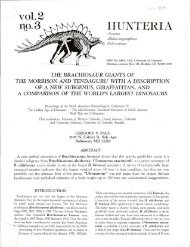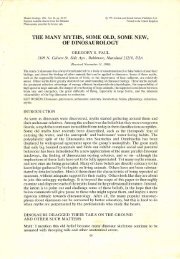Forelimb posture in neoceratopsian dinosaurs - Gregory S. Paul
Forelimb posture in neoceratopsian dinosaurs - Gregory S. Paul
Forelimb posture in neoceratopsian dinosaurs - Gregory S. Paul
You also want an ePaper? Increase the reach of your titles
YUMPU automatically turns print PDFs into web optimized ePapers that Google loves.
456 GREGORY S. PAUL AND PER CHRISTIANSEN<br />
FTGURE4. Comparison of relative forelimb flexion, with left limb elements <strong>in</strong> planar lateral view, drawn to same<br />
humerus length. A, Columnar-limbed Apatosaurus (A). B-D, Animals with jo<strong>in</strong>t flexure <strong>in</strong> the limbs: Leptoceratops<br />
(B), Chasltlosaurus (C), and Triceratops (D). E, Estimated maximum protraction and retraction of humerus <strong>in</strong> Triceratops.<br />
to the ribs (Lull 1933:Plate IIA; Osborn 1933;<br />
Erickson 1966)are probably erroneous, as also<br />
concluded by Adams (1991) and Ford (1997).<br />
In laterally compressed, articulated specimens<br />
the sternals are usually displaced anteroventrally,<br />
perhaps because of bloat<strong>in</strong>g of the<br />
carcass (e.g., Lull 1933:Plates IXA, X).Anteroventral<br />
displacement of the sternals would<br />
also tend to pull the episternum and scapulocoracoid<br />
anteriorly, thus giv<strong>in</strong>g the false impression<br />
of a substantial part of the shoulder<br />
girdle be<strong>in</strong>g anterior to the chest ribs (e.g.,<br />
Centrosaurus AMNH 5351; Brown 1917: Plate<br />
XI). Apart from be<strong>in</strong>g unrealistic, such a position<br />
would leave the girdle with <strong>in</strong>sufficient<br />
support from the M. serratus ventralis.<br />
Rather, the scapula was astride and connected<br />
to the chest ribs as <strong>in</strong> extant tetrapods<br />
except turtles (Romer 1956; Pritchard 1979;<br />
Young 1981;Ford 1997).It is important to bear<br />
<strong>in</strong> m<strong>in</strong>d, however, that although the pectoral<br />
girdle was set far posteriorly <strong>in</strong> ceratopsians,<br />
the posterior sweep of the anterior chest ribs<br />
meant that the glenoid was still situated anterior<br />
to the ribs (Fig. lA-E). This is similar to<br />
the condition <strong>in</strong> many extant birds and reptiles,<br />
but it differs from the condition <strong>in</strong> mammals,<br />
<strong>in</strong> which the glenoid is lateral to the ribs<br />
(Fig. lEG).<br />
The glenoids of sprawl<strong>in</strong>g reptiles face predom<strong>in</strong>ately<br />
laterally to allow the humerus to<br />
perform significant dorsoventral and anteroposterior<br />
movements, and it is usually somewhat<br />
saddle-shaped (e.g., Romer 1956;Young<br />
1981; Bakker 1986,1987). The glenoids of ceratopsians<br />
did not look like this (Fig. 3). The<br />
glenoids of parasagittal mammals are cotyloid<br />
<strong>in</strong> shape and the articulat<strong>in</strong>g facet faces<br />
posteroventrally. Well-preserved, largely uncrushed<br />
ceratopsian scapulocoracoids, e.g.,<br />
Pentaceratops PMUR268 (Wiman 1930),Centrosaurus<br />
YPM 2015 (Lull 1933), or Styracosaurus<br />
FORELIMB POSTURES IN NEOCERA TOPSIAN DINOSAURS 457<br />
AMNH 5372 (Brown and SchIaikjer 1937),<br />
have cotyloid glenoids that ma<strong>in</strong>ly face posteroventrally<br />
and that have only a moderate<br />
ventrolateral flar<strong>in</strong>g, especially on the coracoid<br />
part. Good examples are Triceratops<br />
USNM 4800 (Hatcher et a1.1907),Chasmosaurus<br />
TMM42303-1(Lehman 1989),Peniaceraiops<br />
UNM FKK-081 (Lehman 1993). Crush<strong>in</strong>g<br />
sometimes exaggerates this lateral flar<strong>in</strong>g, as<br />
<strong>in</strong> Torosaurus MPM VP6841 (Johnson and Ostrom<br />
1995).<br />
The dorsal part of the glenoid appears<br />
ma<strong>in</strong>ly to have faced slightly medially <strong>in</strong> most<br />
cases. With a correctly oriented, sharply <strong>in</strong>cl<strong>in</strong>ed<br />
scapula and coracoids that almost meet<br />
at the midl<strong>in</strong>e, the dorsal part of the glenoid<br />
would face even slightly more medially, as<br />
also concluded by Ford (1997).This appears to<br />
have been the case <strong>in</strong> well-preserved ceratopsids<br />
as well as protoceratopsids. This posteroventral<br />
orientation of the glenoid probably<br />
would have prevented the humerus from significant<br />
lateral mobility.<br />
The cotyloid glenoid fossa also strongly argues<br />
aga<strong>in</strong>st a sprawl<strong>in</strong>g forelimb, as the<br />
thrust from carry<strong>in</strong>g the body mass would<br />
have been directed mediodorsally upon contraction<br />
of the presumably massive M. pectoralis.<br />
However, the glenoid does not have a<br />
wide flar<strong>in</strong>g to brace the humeral caput medially,<br />
and thus there appears to have been little<br />
osteological support for a lateral thrust, as<br />
noted for the acetabulum-femur articulation<br />
<strong>in</strong> Plaieosaurus by Christian et al. (1996).Even<br />
columnar-limbed sauropods often have some<br />
lateral flar<strong>in</strong>g of the glenoid, especially <strong>in</strong> the<br />
coracoid part, although it is usually less than<br />
<strong>in</strong> ceratopsians. The rugosity of the sauropod<br />
glenoid often makes this character hard to verify,<br />
however, and some specimens appear to<br />
lack this feature. In ceratopsids the glenoid<br />
was directed as much as 50 0 more posteriorly<br />
along the parasagittal plane than <strong>in</strong> columnarlimbed<br />
sauropods and stegosaurs (Fig.4A-D).<br />
Glenoid morphology <strong>in</strong>dicates that the humeral<br />
<strong>posture</strong> was ungulate-like (Figs. 5B,C<br />
and 6) with flexion primarily <strong>in</strong> the anteroposterior<br />
plane, rather than transverse as <strong>in</strong><br />
reptiles. In ceratopsids the glenoids were<br />
probably directed approximately 10° more<br />
ventrally than was the case <strong>in</strong> small protocer-<br />
atopsids (Fig. 4B-D). The slight lateral flar<strong>in</strong>g<br />
of the ventral part of the glenoid probably allowed<br />
the humerus to slope an estimated 20-<br />
25 0<br />
ventrolaterally (Figs. 1A-E, 3A, 4E, 6D).<br />
The orientation of the scapula ranges from<br />
horizontal to almost vertical <strong>in</strong> articulated ceratopsian<br />
specimens (Lull 1933:Plate IXA).The<br />
former is depicted <strong>in</strong> some restorations (Sternberg<br />
1927;Erickson 1966;Johnson and Ostrom<br />
1995), but horizontal scapulae appear to be<br />
largely limited to specialized tetrapods with<br />
very elongated coracoids, such as certa<strong>in</strong> advanced<br />
non-avian theropods, birds, and<br />
pterosaurs (<strong>Paul</strong> 1987, 1988). In most tetrapods<br />
the scapula is posteriorly <strong>in</strong>cl<strong>in</strong>ed, and<br />
this is the most likely orientation <strong>in</strong> ceratopsian<br />
d<strong>in</strong>osaurs as well (Fig. 1A--G) (Russell<br />
1970; Ostrom and Wellnhofer 1986; Tereshchenko<br />
1994; Ford 1997; Garstka and Burnham<br />
1997).<br />
Scapular Mobility.-One aspect of ceratopsian<br />
limb function that has generated substantial<br />
controversy is scapular mobility. Well-developed<br />
scapular mobility is favored by Bakker<br />
(1986, 1987), <strong>Paul</strong> (1987), Tereshchenko<br />
(1994),and <strong>in</strong> part Gilmore (1919),while Bennett<br />
and Dalzell (1973),Coombs (1978),Thulborn,<br />
(1982), Adams (1991), and Dodson<br />
(1996) suggested that it was either very limited<br />
or did not occur. Scapular mobility is present<br />
<strong>in</strong> a variety of amniote groups; it occurs<br />
<strong>in</strong> several lizards (Jenk<strong>in</strong>s and Goslow 1983)<br />
and is well developed <strong>in</strong> chameleons (Peterson<br />
1984; Bakker 1986, 1987), crocodilians, and<br />
many mammals (Fig. 5B-D) (Gambaryan<br />
1974; Jenk<strong>in</strong>s and Weijs 1979). Although the<br />
functional anatomy differs markedly among<br />
the various groups, it is clear, however, that<br />
scapular mobility is common among arnniotes.<br />
A substantial degree of mobility is reta<strong>in</strong>ed<br />
among large mammals, although it is reduced<br />
<strong>in</strong> columnar-limbed elephants (Fig. 5D)<br />
(Gambaryan 1974). To atta<strong>in</strong> scapular mobility<br />
the coracoids can be lost, as <strong>in</strong> most mammals,<br />
or alternatively, the coracoids can be allowed<br />
to slide fore and aft <strong>in</strong> a groove on the<br />
lateral edge of the sternum, as <strong>in</strong> Varanus (Jenk<strong>in</strong>s<br />
and Goslow 1983). Paired clavicles are<br />
present <strong>in</strong> Protoceratops and Leptoceratops but<br />
have not been found <strong>in</strong> ceratopsids yet (Dod-









